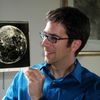
Neil deGrasse Tyson is wrong. It pains me to write it but the world-famous astrophysicist, Director of the Hayden Planetarium in New York City and superstar of our field is a Supermoon hater.
As the Moon orbits the Earth, it slowly changes its distance from us. It varies from about 252,000 miles at its farthest, to around 220,000 miles at its closest. When you combine the night when the full moon is also closest to us for the year: that is called a Supermoon. Tyson argues passionately, "So what?" He wants to talk about real discoveries, not some made-up event.
When the Supermoon phenomenon hit a few years ago I was similarly skeptical. Astronomers must naturally be wary of the media when it comes to reporting astronomy stories. We've seen so many articles that overblow small discoveries, ignore large ones, garble facts, and miss the point. On the surface, the Supermoon seemed like another one -- another over-hyped event that would confuse and anger the public when they observed a Moon no larger than the one in their memories. But I was wrong. The media can handle it and the public loves it.
It's true that the average person can't tell a Supermoon from an average Moon. Tyson likens the changing distance to a pizza. "If you had a 16-inch pizza, would you call that a 'Super Pizza?' Compared to a 15-inch pizza?" Yes I would, and we do, and we pay extra for it.
The Moon's distance changes very slowly. You can't tell the difference from night to night. But if you compare a Supermoon to the farthest full moon, the so-called Wimpy Moon of January 15, 2014, the difference is dramatic. The Supermoon is over 31,000 miles closer, appears 14% larger in diameter and 30% larger in surface area than the Wimpy Moon. That would be like comparing a 14" pizza (on the wimpy-size) to a 16" pizza (on the super-size). When there is a wimpy moon in the sky, I can tell.

Perfect Media Event
The media loves the Supermoon. It's a story they can understand, communicate well, and show graphically. It has been broadcast everywhere for the past three years and definitely strikes a chord with the public. In 2011 the Cincinnati Observatory fielded so many calls about the Supermoon that we had to do something. Still skeptical, I grudgingly scheduled a public open house to view the event in 2012. Its selling point was that it was to occur on a Saturday night in May -- a prime night to get the public to attend when the weather would be ideal for watching a moon rise.
Hundreds of people showed up, and they loved it. We gathered on the east-facing lawn anxiously awaiting the moonrise over the verdant hillside. I found the crowd's expectations to be well-managed. They definitely weren't expecting a Moon twice as large as normal. They were just thrilled to be outdoors with fellow star gazers, fellow neighbors, watching a celestial dance and a beautiful spring evening. They took time out of their day to sit and stand and notice and experience something in the heavens.
And then the Moon showed, hesitant at first, delicate, a faint glowing orb emerging from the spring haze. "I see it! I see it!" a first grader exclaimed, "There it is," a woman in red added. "Oh it's so beautiful!" I heard.
I've seen countless moonrises, but never have I shared it with so many people. I looked at the glowing faces watching the moonrise with awe. Parents held their kids' hands or up in their arms, pointing and smiling. Couples with arms entwined beamed. People kissed. "Wow," I heard reverberate through the crowd. To someone in my field, that loves astronomy and sharing these views more than anything in the world, what could be better? Finally I couldn't hold back my emotion. I yelled, "SUPERMOON!" at the top of my lungs. And the crowd echoed with a howl of their own. We shared something that night.
We repeated this celebration again on June 22, 2013 and I was once again moved by the power of the Supermoon. This time we had an even larger crowd lining the hillsides to watch it together -- some for the first time others for a repeat. Everyone was so happy. It was like a festival of the Moon.
So now I'm a Supermoon lover. Why not do this once a year? Why not make an event around something so beautiful open to everyone around the world? At first the Supermoon was an excuse to get people outside and look up. Now it is not only a teachable moment but a beautiful celebration of our place in the universe. I think it should be an astronomical holiday.
A Supermoon program may not be an added draw to larger science centers and planetariums, but the smaller centers with no advertising budgets should embrace them. In 2014 the best night to watch the Supermoon will occur on a Saturday once more (August 9). And looking ahead, something Neil deGrasse Tyson should love, the Supermoon of 2015 will occur on Sunday September 27 during a total lunar eclipse visible from almost everywhere in the United States. Get ready for the Supermoon Eclipse of 2015. I can't wait.
Dean Regas is the astronomer at the Cincinnati Observatory and co-host of the PBS program Star Gazers. He can be reached at dean@cincinnatiobservatory.org
